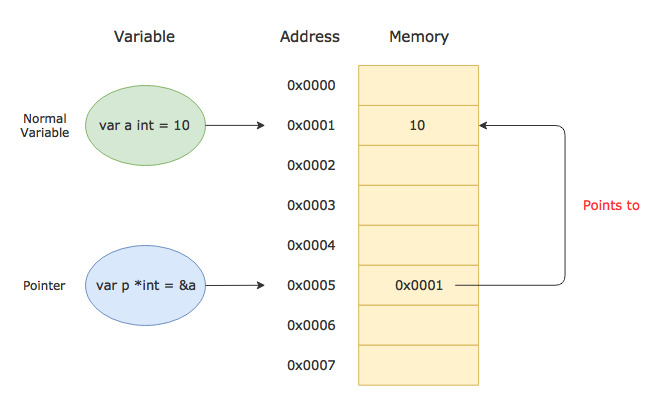-
Notifications
You must be signed in to change notification settings - Fork 50
0x01. Pointers in Golang
A pointer is a variable that stores the memory address of another variable.
/!\ Before read this, you can visit another post to know more detail about
What is memory?andWhat is a variable?
Let’s break this down.
Let’s first understand what a variable is. Well, Whenever we write any program, we need to store some data/information in memory. The data is stored in memory at a particular address. The memory addresses look something like 0xAFFFF (That’s a hexadecimal representation of a memory address).
Now, To access the data, we need to know the address where it is stored. We can keep track of all the memory addresses where the data related to our program is stored. But imagine how hard it would be to remember all those memory addresses and access data using them.
That is why we have the concept of variables. A variable is just a convenient name given to a memory location where the data is stored.
A pointer is also a variable. But it’s a special kind of variable because the data that it stores is not just any normal value like a simple integer or a string, it’s a memory address of another variable

In the above example, the pointer p contains the value 0x0001 which is the address of the variable a.
A pointer of type T is declared using the following syntax
// A pointer of type T
var p *TThe type T is the type of the variable that the pointer points to. For example, following is a pointer of type int
// A pointer of type int
var p *intThe above pointer can only store the memory address of int variables.
The zero value of a pointer is nil. That means any uninitialized pointer will have the value nil. Let’s see a complete example.
package main
import "fmt"
func main() {
var p *int
fmt.Println("p = ", p)
}# Output
p = <nil>You can initialize a pointer with the memory address of another variable. The address of a variable can be retrieved using the & operator
var x = 100
var p *int = &xNotice how we use the & operator with the variable x to get its address, and then assign the address to the pointer p.
Just like any other variable in Golang, the type of a pointer variable is also inferred by the compiler. So you can omit the type declaration from the pointer p in the above example and write it like so:
var p = &aLet’s see a complete example to make things more clear
package main
import "fmt"
func main() {
var a = 5.67
var p = &a
fmt.Println("Value stored in variable a = ", a)
fmt.Println("Address of variable a = ", &a)
fmt.Println("Value stored in variable p = ", p)
}# Output
Value stored in variable a = 5.67
Address of variable a = 0xc4200120a8
Value stored in variable p = 0xc4200120a8You can use the * operator on a pointer to access the value stored in the variable that the pointer points to. This is called dereferencing or indirecting
package main
import "fmt"
func main() {
var a = 100
var p = &a
fmt.Println("a = ", a)
fmt.Println("p = ", p)
fmt.Println("*p = ", *p)
}# Output
a = 100
p = 0xc4200120a8
*p = 100You can not only access the value of the pointed variable using * operator, but you can change it as well. The following example sets the value stored in the variable a through the pointer p
package main
import "fmt"
func main() {
var a = 1000
var p = &a
fmt.Println("a (before) = ", a)
// Changing the value stored in the pointed variable through the pointer
*p = 2000
fmt.Println("a (after) = ", a)
}# Output
a (before) = 1000
a (after) = 2000You can also create a pointer using the built-in new() function. The new() function takes a type as an argument, allocates enough memory to accommodate a value of that type, and returns a pointer to it.
Here is an example:
package main
import "fmt"
func main() {
ptr := new(int) // Pointer to an `int` type
*ptr = 100
fmt.Printf("Ptr = %#x, Ptr value = %d\n", ptr, *ptr)
}# Output
Ptr = 0xc420014058, Ptr value = 100A pointer can point to a variable of any type. It can point to another pointer as well. The following example shows how to create a pointer to another pointer
package main
import "fmt"
func main() {
var a = 7.98
var p = &a
var pp = &p
fmt.Println("a = ", a)
fmt.Println("address of a = ", &a)
fmt.Println("p = ", p)
fmt.Println("address of p = ", &p)
fmt.Println("pp = ", pp)
// Dereferencing a pointer to pointer
fmt.Println("*pp = ", *pp)
fmt.Println("**pp = ", **pp)
}# Output
a = 7.98
address of a = 0xc4200120a8
p = 0xc4200120a8
address of p = 0xc42000c028
pp = 0xc42000c028
*pp = 0xc4200120a8
**pp = 7.98ⓒ 2019 Phú, Trần Phong & NordicCoder